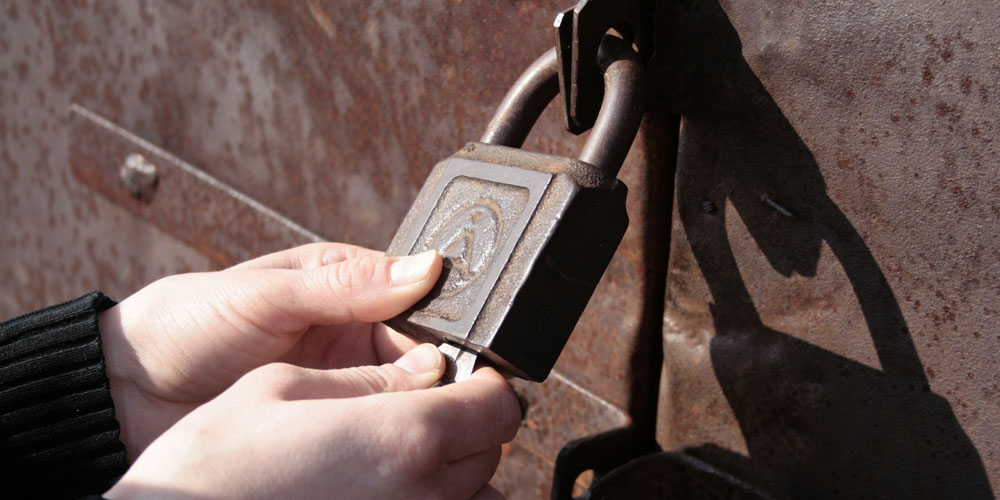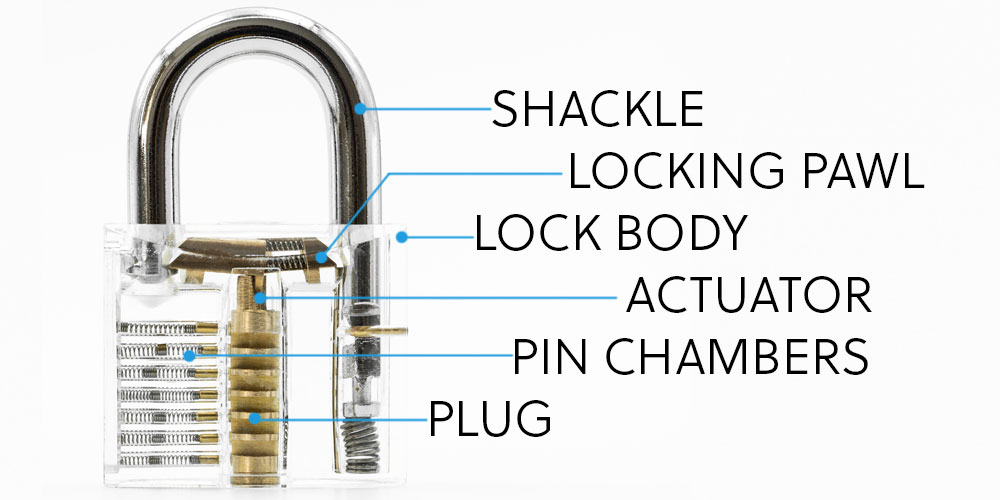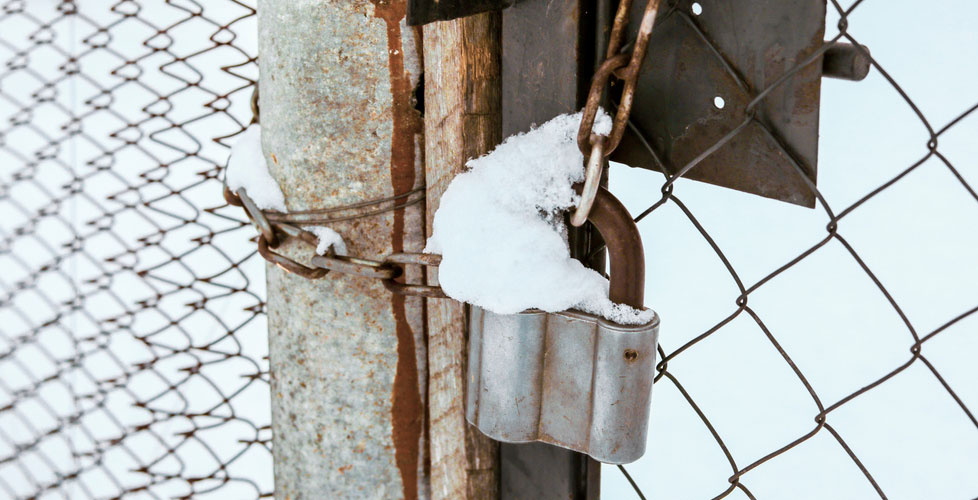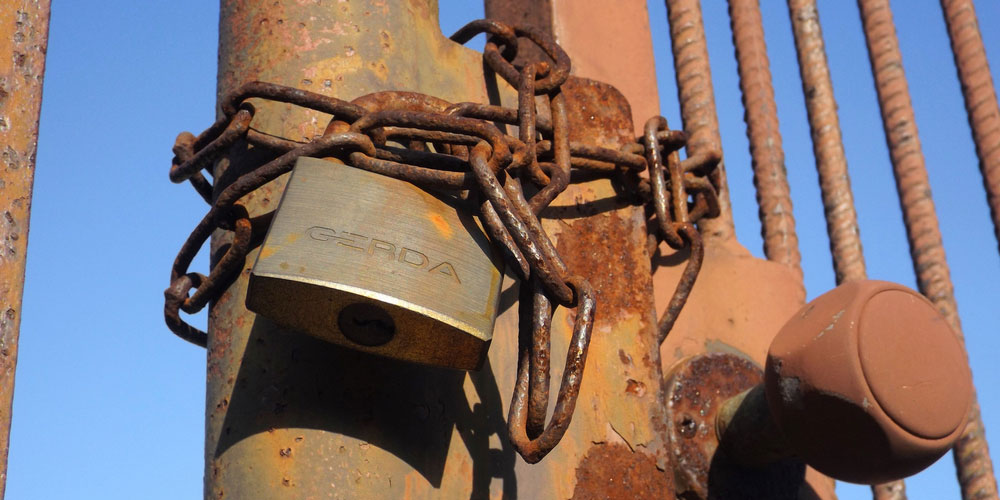Lock Blog
A resource for consumers, locksmiths, and security professionals
A resource for consumers, locksmiths, and security professionals

A padlock broken is a padlock lost. But just because a padlock won’t open does not necessarily mean that the padlock is broken. There are many reasons for a padlock not opening, and they have solutions that do not always call for the brute force burglary tactics of cutting, prying, or drilling. In some cases, you will need a locksmith, but this information should allow you to do some of the work yourself.
The most common reasons a padlock won’t open include:

There are many padlock variations, such as combination locks and U-locks. And not even every keyed padlock uses a pin tumbler system. But when you understand how the most basic lock works, it will give you better insight into when a non-standard padlock won’t open. This is not a complete overview of the history of padlocks, just a snapshot of their current form.
Shackle – The U-shaped length of metal that loops into the hasp on a door, gate, etc. Cuts at the base of the catch the locking pawls so the shackle does not slide freely out of the lock body.
Locking Pawl – When the shackle is fully inserted, the cut on the end will catch on the locking pawl. Once caught, the locking pawl will need to be retracted in order for the shackle to pull free from the lock body.
Lock body – The housing for all of the internal components where the shackle secures to the locking pawl. There are often three entry points including the plug’s keyway, shackle hole, and drain hole (to allow water to flow out).
Actuator – Located on the back of the plug, this component will retract the locking pawl when the plug is turned.
Pin chambers – In standard pin tumbler locks, the driver pins must be moved out of the plug into their respective pin chambers so the plug can rotate.
Plug – When you look at the keyway of a padlock, you are looking at the plug. The key is inserted into the plug, which will be rotated to move the actuator and retract the locking pawls.
Now that you understand the basic parts of a padlock, you will be able to better understand the internal processes that are being interrupted by the broken padlock. When a padlock won’t open, it is because something is wrong with the way these parts are interacting. So let’s get into what might be the reason for your padlock not opening and how to fix the problem.
The most common reason for a padlock keyway being blocked is because a key broke off in the lock. Besides the key, people will sometimes stick foreign objects into the keyhole. This may not be visually apparent if objects have been forced into the recesses of the keyway, but you will notice that the key will not fully insert.
If the keyway is filled with material that breaks up such as wood, dirt, foam, etc., the lock will need to be cleaned for it to be fully restored. There is also the additional time it will take to remove all the pieces as the substance breaks apart. If you are in an emergency situation, you may not have the time to pick the fragments out of the lock and will need to cut the lock.
In the most severe cases, whatever was put inside the keyway can move up from the plug to the upper pin chambers and will not be cleanable. Not every padlock has a key. In fact, many bike locks and locker locks use combination wheels. These wheels can get blocked from moving or bind up, but we will discuss stuck combination wheels later on.
Solution:
Even if you are not removing a broken key from your lock, you will still be going through the same type of remedies. You will need an object slim enough to slip alongside the blockage and leverage it as you pull out. Your tool must be strong enough not to break and cause more debris to clog the keyway.
If a padlock won’t open due to a jammed shackle, the key should still turn in the lock. This will not always be a full turn, but the cylinder in the padlock should rotate at least partially. If the cylinder can spin continuously without meeting resistance, there is likely something else wrong with the lock (this could be the sign of a broken actuator).
The shackle is going to be jammed as the result of a blockage in the shackle hole, or broken component, which is causing the locking pawl not to retract. The locking pawl might not be fully disengaged, or it is disengaged but the shackle is binding on something else. You likely encountered a door lock jammed in this way before, when the deadbolt will not retract.
A shackle may be jammed due to rust, but we will talk about that more specifically in another section. In this instance, the padlock won’t open because of other forms of blockage. This might be dirt, metal shavings from grinding parts, etc. Now there is an excess of material within the lock which is not allowing parts to move or slide past one another properly.
Solution:
When a padlock won’t open because of a jammed shackle, you are going to have to focus on clearing the non-rust blockage. Graphite lubricant is recommended because it is a dry lube, unlike popular brands like WD-40, which are oil-based. Oil-based lubricants can collect particulates over time and land you right back in this situation.
A reliable sign of a broken actuator is when a key keeps turning in the lock. Alternatively, when a padlock won’t open because of a broken actuator the key may turn correctly, with no resistance, but stop at the appropriate rotational point. The symptom indicative of the broken padlock will depend on what precisely is broken.
Regardless of what has broken, the underlying issue is that there is no longer a connection between the keyway and the device releasing the shackle. The shackle stays in place via two locking pawls which retract when the key turns and influences the actuator. If any part of that process breaks down, the shackle cannot release and the padlock won’t open.
This issue could be similar to how to fix a stuck door latch if the locking pawls are spring-loaded and free-moving. In the case of high-security padlocks, the locking pawls will act more like deadbolts, requiring the actuator to open the lock. You might be able to interact with the actuator by reaching a tool through the keyway, but this is not always possible.
Solution:
When a padlock won’t open due to a broken actuator, it means the keyway is as good as useless for getting the lock open. To remove a broken padlock that has issues with its actuator you will most likely have to cut the lock open. You may have the option of shimming the lock or bypassing the actuator if you have a particularly low-security lock, but cutting will be easier.

To freeze to the point where a padlock won’t open, all you need is freezing temperatures. The area where the lock resides should show signs of frost. Because the surrounding ice is melting naturally the ice in the lock will do the same. In some cases, the frost may hold on longer inside the lock, but it should be in the process of melting.
Even if your lock is not near water, there can be enough moisture in the air to make sure a padlock won’t open. If the lock is exposed to large amounts of water, the chances of a frozen padlock increase. In many cases, you will not be able to prevent this seasonal issue from recurring, but there are weather-resistant covers that reduce the accumulation of internal moisture.
The best padlocks can still freeze, but no lock should be harmed by this. The harm will come from trying to force the lock to work and over-torquing the key. And if the lock is not properly drained of the melted ice, it can rust. Most padlocks will have drain holes on the lock body, but if the padlock is positioned so the hole is facing up, gravity cannot do its job.
Solution:
Isopropyl alcohol is the best solution when a padlock won’t open because of ice. You can use rubbing alcohol or hand sanitizer so you are not adding water for future freezing and rust. Heating the lock can also work, but getting a heat source to the lock may prove difficult. However, the ice is melted, be sure the moisture drains out of the lock.
When a keyed padlock won’t open, there may be an issue with the key. A key not turning should be unique from the symptoms of a stuck shackle. The key will insert, but will not affect the lock at all. It will be as if the wrong key was inserted. If the key is not inserting correctly, check the section on blocked keyways.
A damaged key may be responsible for the issue, or the padlock is broken in one of the other ways discussed elsewhere in the article. You can take a look at your key and check for signs of wear. Just by touch, you can tell whether the teeth of the key have smoothed and rounded, and lost the sharp and pointy form that properly lifts the pins.
The easiest way to determine if a padlock won’t open because of a key-related issue is to use a spare key. Keyed padlocks will come with at least two keys. See if you can find your spare key, test it in the padlock. If the issue persists with a second key, then there is likely something wrong with the lock and not the key.
Solution:
When the reason a padlock won’t open is your key, you likely will not be able to fix the broken key. You will instead be looking to make a new key from the lock, which will require a locksmith. Via methods such as lock impressioning and key decoding, a new key can be cut from code. Duplicating a worn key will only get you a second key that does not work.
It doesn’t matter if your padlock uses a single combination wheel or multiple combination wheels, they break down for similar reasons. The most common reason for a combination padlock not opening because of the wheel binding is shackle tension. When the shackle is pulled, the wheel(s) will not move and the padlock won’t open.
Without the shackle being pulled, there may still be something raising the shackle or tensioning it to create a similar effect. Something may be jammed into the crevice between the shackle and lock body, keeping the shackle pushed up (instead of pulled). Pull on the shackle and make sure that there is a bit of give. When the shackle does not move up slightly, it is jammed.
If your shackle is not stuck and is not being tensioned, refer to the section on rust build-up. With a combination padlock not opening when it is outside in the extreme cold, you can take steps to treat it as frozen. If there is a method to change the padlock combination such as a change key or external device, you may try using this to free up the combination wheel.
Solution:
If the shackle does not move at all, apply lubricant. The application points include the space between the shackle and the lock body, the combination wheel(s), and the drain hole. With the lube applied, pull on the shackle and spin the wheels. Even if there is material jammed inside the binding points of the lock, the lubricant may allow them to slip free.

This is very common with old or antique locks. The accumulation of rust may be the reason a padlock won’t open, even if there are no visible signs of excessive build-up. This is especially true when the padlock has a stainless steel shackle and body which cannot rust. However, certain internal elements may corrode even though the exterior is untarnished.
Rust is the product of a chemical change where iron bonds to oxygen and water (H2O). The iron is becoming iron oxide, manifesting as a reddish-brown substance, which comes apart as flakes. Those flakes can block the keyway or jam internal components. The components themselves can also degrade to the point where they break to the point where the padlock won’t open.
Rust is a very common reason why an outdoor padlock won’t open. Risks of rust increase based on proximity to water. Areas with reliable moisture exposure include yards with regular sprinkler use, boat storage, pool gates, etc. If your lock freezes or has frozen, the moisture created by ice melting can create an accumulation of rust.
Solution:
Though WD-40 can cause locks to gum up over time as the oil collects dust and grime, it does remove rust. You can spray the lubricant into the various openings on the lock (keyway, drain hole, shackle holes, etc.) and then test the lock again. Make sure to turn the key and pull on the shackle in quick repetitive motions to try and break up the rust. Once open, wipe away liquified rust residue.
Don’t leave a broken padlock where it is. When a padlock won’t open, remove it. This is essentially true when you are changing locks on a new home, where you need to gain access to every part of the property. Broken padlocks in retail security settings or shared living accommodations are especially important to address as they can block emergency evacuation routes.
Category: Commercial, Residential